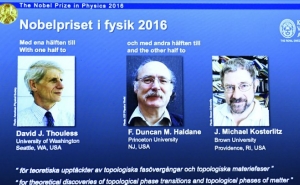Nobel Prize in Physics Awarded for Work on Cosmology

There are two methods that astronomers use to spot planets around other stars. One is the so-called transit method where scientists watch for planets as they wander across the face of their parent star, The Guardian reports.
Even though the star is but a pinprick in the heavens, sensitive telescopes can often detect the minuscule dimming of the starlight as the planet goes by and casts its shadow on the detector. It’s been extremely successful - Nasa’s Kepler’s mission is but one that has exploiting transits to find hoards of new planets.
Mayor and Queloz used a different technique. They looked at how stars are pulled around by planets that swing around them. The method exploits the Doppler effect. In this case, as a planet’s gravity pulls its star towards Earth - with its telescope-wielding astronomers - light from the star is shifted towards the blue wavelengths of the electromagnetic spectrum. The rays are basically squeezed up, making them bluer. As the planet goes around the star and pulls it backwards, the starlight is stretched out and so turns more towards the red end of the electromagnetic spectrum.
-
 17:08
17:08The regular session of the Anti-corruption Policy Council takes place in Jermuk
-
 15:05
15:05The Prime Minister sends congratulatory messages to the supreme leader of Iran and the President of Iran
-
 11:11
11:11Armenia sends earthquake aid to Turkey
-
 10:43
10:43Commemoration of the Pontiff St. Sahak Partev
-
 09:16
09:16Some roads are closed and difficult to pass in Armenia
-
 19:55
19:55Phone conversation of the Foreign Minister of Armenia with the U.S. Assistant Secretary of State for European and Eurasian Affairs
-
 18:30
18:30Prime Minister Pashinyan and President Khachaturyan meet
-
 18:20
18:20Ararat Mirzoyan with Co-Chairman of the OSCE Minsk Group of France Brice Roquefeuil
-
 17:01
17:01Humans could land on Mars within 10 years, Musk predicts
-
 16:45
16:45France, US urge 'immediate' end to Nagorno Karabakh blockade
-
 16:01
16:01Blockaded Nagorno Karabakh launches fundraiser to support quake-hit Syria
-
 15:59
15:59Earthquake death toll in Turkey rises to 18,342
-
 15:43
15:43Ararat Mirzoyan Held a Telephone Conversation with Sergey Lavrov
-
 15:06
15:06French president rules out fighter jet supplies to Ukraine in near future
-
 14:47
14:475 Day Weather Forecast in Armenia
-
 14:44
14:44President Vahagn Khachaturyan wrote a note in the book of condolences opened in the Embassy of Syria in Armenia
-
 14:20
14:20Azerbaijan’s provocations impede establishment of peace and stability – Armenian FM tells Russian Co-Chair of OSCE MG
-
 12:57
12:57France representation to OSCE: Paris calls on Azerbaijan to restore freedom of movement through Lachin corridor
-
 11:40
11:40Command of Kosovo forces highly appreciated preparation of Armenian peacekeepers
-
 10:16
10:16The United States withdrew from sanctions against Syria for six months the provision of assistance after the earthquake
day
week
month
Humidity: %
Wind: km/h









